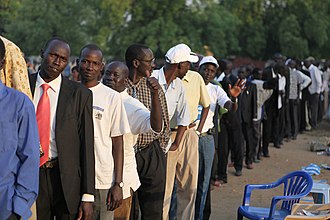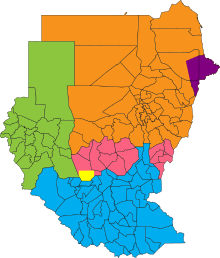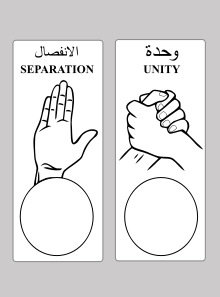Independence referendum in South Sudan in 2011

In the independence referendum in South Sudan in 2011 , which took place from January 9-15, 2011, the people of South Sudan decided whether the area would remain part of Sudan or become independent as a separate state.
According to the official final result, around 99% of voters were in favor of independence. 3.8 million voters voted for an independent state, with just under 45,000 in favor of staying with Sudan. As a result, South Sudan became independent on July 9, 2011.
background

The referendum goes back to the 2005 peace treaty that ended the civil war in South Sudan. Before that, rebels in South Sudan had fought for greater autonomy or independence from 1956 to 1972 and again from 1983, while the central government took action using the army and paramilitary militias. The reasons for the conflict were the historical relations between South and North Sudan, economic interests in the natural resources of the South, ethnic and religious disparities and the lack of political participation of South Sudan both in its own region and in the country as a whole.
According to the peace agreement signed by the government and the SPLA rebels in 2005, South Sudan became an autonomous region within Sudan, and a referendum was scheduled for early 2011 in which the South Sudanese people would choose between independence and remaining in Sudan.
At the same time, a separate referendum was planned for the controversial Abyei area, which should decide whether this area should belong to the north or the south in the future. However, this referendum was canceled until further notice as the north and south could not agree on who would be eligible to vote. Popular consultations are planned for the Nuba Mountains and parts of an-Nil al-azraq - which are located in northern Sudan, but where parts of the population on the southern side took part in the war - but this is only vaguely defined.
Preparations
The Sudanese President Omar al-Bashir emphasized in April 2010 that he would recognize the result of the referendum. However, this has been questioned because of the great economic importance of oil reserves in South Sudan.
In October 2010 it became known that preparations for the referendum were weeks behind schedule. The chairman of the electoral commission, Mohammed Ibrahim Khalil, announced that voter registration could not take place until November.
In mid-November 2010, the registration for the election began in the 2,600 stations, which lasted until December 1. Omar al-Bashir's party, the National Congress Party (NCP), accused the former rebel movement, the SPLM , of obstructing registration in the capital, Khartoum . For its part, the SPLM feared that the NCP would put northern Sudanese on the list there, who would then boycott the voter turnout below the required level of 60 percent.
Because of the civil war, numerous South Sudanese had fled to the north since the 1980s. In mid-2010, around 2.5 million refugees were living in the greater Khartoum area. Over a million of them returned to their homeland at the end of 2010 to take part in the referendum. In the event of independence, they hoped for greater security and better living conditions there. Voting was also possible in the north, but most South Sudanese feared election fraud and later attacks by the Sudanese regime. Among other things, a minister had threatened acts of revenge in the event of independence. The electoral offices in Khartoum therefore remained largely empty during registration, which was also expected for the referendum on January 9, 2011, but did not materialize.
At the end of the voter registration, around four million people had been registered in South Sudan as well as a further ten thousand South Sudanese in North Sudan and exiled Sudanese in neighboring African countries, in North America and Europe.
Since the majority of South Sudanese are illiterate, the design of the ballot papers has been the subject of discussion. It was finally agreed on a waving hand as a symbol for "independence" and two faithful hands as a symbol for "unity". The voters would fill out the slip of paper by fingerprint. The image of the waving hand was made known with posters, stickers, T-shirts, etc.
International election observation
There were fears that there could be another war between the north and the south after the referendum. Both sides had massively upgraded in advance. In previous years, the SPLM had accused the north of secretly arming tribal militias in order to destabilize the south.
The referendum was monitored by around 3,000 foreign election observers, including more than 100 EU election observers, representatives of the United Nations Security Council and observers from the African Union , various churches and local non-governmental organizations .
The organization Not on Our Watch , in cooperation with Google , the United Nations and various anti- genocide organizations under the name Satellite Sentinel, organized continuous surveillance of the area with high-resolution real-time satellite images . The focus was on troop movements and changes among the civilian population.
execution
The referendum started on schedule and all polling stations opened on time. The national referendum commission in Khartoum was responsible . 60,000 police officers protected the ballot boxes and the polling stations.
Observers praised the largely peaceful electoral process and reported a high turnout. Few violent incidents were recorded. On January 9, 2011, 20 South Sudanese police officers were killed and 30 injured in two attacks with anti-tank weapons and artillery in Abyei . The South Sudanese government accused Arab tribesmen and the North Sudanese armed forces of carrying out the attack. Otherwise, the referendum should have started peacefully.
Results
On January 12, 2011, the SPLM announced that the required quorum of 60 percent had been achieved. The first interim results already indicated an approval of around 99 percent for independence. On January 25, the Sudanese President Omar Hassan al-Bashir made his first public statement on the results and acknowledged that the South had voted for independence.
The preliminary official result published on January 30, 2011 confirmed the interim results. Accordingly, 3.8 million voters (98.8 percent) spoke out in favor of independence. Only just under 45,000 South Sudanese voted for unity, especially in North Sudan, where the percentage of votes for independence was by far the lowest at 58%. The only region in which a majority of voters opposed independence was South Darfur , where only about 9,000 people voted. The South Sudanese abroad, who mainly exercised their right to vote in the neighboring states of Kenya, Uganda, Ethiopia and Egypt, also voted for independence with a large majority.
In the first official reaction from Khartoum following the announcement of the preliminary final result, Vice President Ali Osman Taha said on January 31, 2011 that the government of Sudan agreed with the outcome of the referendum. The Vice President promised to seek good relations with the new state. On July 9, 2011, the 193rd state in the world was officially founded.
The official final result was announced on the evening of February 7, 2011 in Juba . The Sudanese government under al-Bashir had recently announced that it would recognize the independence of South Sudan. On July 9, 2011, South Sudan became independent.
| Region / State | votes cast |
for independence |
against independence |
Invalid votes |
blank ballot papers |
for independence in percent |
against independence in percent |
|---|---|---|---|---|---|---|---|
| Central Equatoria (central Equatoria) | 457.439 | 449.311 | 4,985 | 1,523 | 1,620 | 98.90% | 1.1% |
| Eastern Equatoria (Eastern Equatoria) | 463.706 | 462,663 | 246 | 70 | 727 | 99.95% | 0.05% |
| Jonglei | 430.056 | 429,583 | 111 | 124 | 238 | 99.97% | 0.03% |
| Lakes (lakes) | 299.040 | 298.214 | 227 | 149 | 450 | 99.92% | 0.08% |
| Northern Bahr el Ghazal (Gazelle River (north)) | 382.049 | 381.141 | 234 | 148 | 526 | 99.94% | 0.06% |
| Unity (unit) | 498.231 | 497,477 | 190 | 166 | 498 | 99.98% | 0.02% |
| Upper Nile (Obernil) | 347,390 | 344,671 | 1,815 | 381 | 523 | 99.48% | 0.52% |
| Warrap | 469,648 | 468.929 | 167 | 120 | 432 | 99.96% | 0.04% |
| Western Bahr el Ghazal (Gazelle River (West)) | 162,594 | 153,839 | 7,237 | 728 | 790 | 95.51% | 4.49% |
| Western Equatoria (West Equatoria) | 214.041 | 211,639 | 1,017 | 382 | 1.003 | 99.52% | 0.48% |
| South Sudanese in Northern Sudan | 69,597 | 38.003 | 27,918 | 2,230 | 1,446 | 57.65% | 42.35% |
| South Sudanese abroad | 58.203 | 57.048 | 841 | 201 | 113 | 98.55% | 1.45% |
| total | 3,851,994 | 3,792,518 | 44,888 | 8,366 | 6.222 | 98.83% | 1.17% |
See also
literature
- James Copnall: A Poisonous Thorn in Our Hearts: Sudan and South Sudan's Bitter and Incomplete Divorce. C. Hurst & Co., London 2014, ISBN 978-1-84904-330-4 .
Web links
- Official website of the referendum. Retrieved January 5, 2011 .
- Official website of the referendum result. Retrieved January 28, 2011 .
- Official website of Satellite Sentinel. In: Satellite Sentinel. Not on Our Watch, accessed December 30, 2010 .
- Joachim Frank: Screams of joy after voting. In: Frankfurter Rundschau . January 12, 2011, accessed on January 12, 2011 (Interview with Josef Sayer, Chairman of the Catholic aid organization Misereor.).
Individual evidence
- ↑ a b South Sudanese vote for independence from the north In: Frankfurter Allgemeine Zeitung of January 30, 2011.
- ↑ Ilona Eveleens: The apple of contention in the heart of Sudan. on taz.de, January 4, 2011.
- ^ The Nuba Mountains - straddling the north-south divide. In: IRIN News of November 12, 2009.
- ↑ Thomas Scheen: Plagues about oil, ethnic groups - and war. In: Frankfurter Allgemeine Zeitung. September 22, 2010. Retrieved September 22, 2010 .
- ↑ Trembling before splitting. In: Frankfurter Rundschau . October 7, 2010, accessed October 7, 2010 .
- ↑ Who is from the south and who is not? . In: taz.de . Retrieved January 9, 2011.
- ↑ Southern returnee deluge leaves aid workers in a quandary. In: IRIN News of December 28, 2010. Retrieved January 4, 2011.
- ↑ Weltspiegel report: New migration of peoples in Sudan. ( Memento of December 19, 2010 in the Internet Archive ) December 18, 2010. Retrieved January 9, 2011.
- ↑ Simone Schlindwein: I still want to experience freedom. In: The daily newspaper. December 8, 2010, accessed December 9, 2010 .
- ↑ a b c Looking forward to a new Sudan. In: tagesschau.de. January 9, 2011; Archived from the original on January 12, 2011 ; Retrieved January 11, 2011 .
- ^ Josh Kron: Referendum Logos Accent Challenges Facing Sudan. In: The New York Times, January 13, 2011.
- ↑ Wikileaks: US 'aware of' Kenya-Southern Sudan arms deal. In: BBC News, December 9, 2010. Retrieved January 4, 2011.
- ↑ Khartoum denies arming militias. In: BBC News, August 13, 2009. Retrieved January 4, 2010.
- ↑ a b c Rush to the polling stations. In: The daily newspaper . January 9, 2011, accessed January 11, 2011 .
- ↑ The world is watching. In: ORF . December 30, 2010, accessed December 30, 2010 .
- ↑ a b 20 police officers killed in Sudan. In: Frankfurter Allgemeine Zeitung. January 10, 2011, accessed January 10, 2011 .
- ↑ see referendum in South Sudan completed at derstandard.at, January 15, 2011 (accessed on January 16, 2011)
- ^ Riots in the border region between North and South Sudan. In: Neue Zürcher Zeitung . January 10, 2011, accessed January 11, 2011 .
- ↑ Required voter quota reached in Sudan's referendum. In: ORF. January 12, 2011, accessed January 12, 2011 .
- ↑ Dominic Johnson : South Sudan votes for independence. on taz.de, January 21, 2011.
- ↑ Clear the way for independence. In: Domradio , January 25, 2011.
- ↑ South Sudan celebrates independence. In: Süddeutsche Zeitung. July 9, 2011, accessed July 10, 2011 .
- ↑ South Sudanese clearly vote for independence. In: Neue Zürcher Zeitung. February 7, 2011, accessed February 9, 2011 .
- ↑ Al-Bashir recognizes the independence of South Sudan. In: ORF. February 7, 2011, accessed February 7, 2011 .
